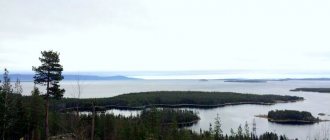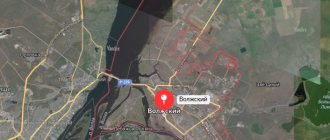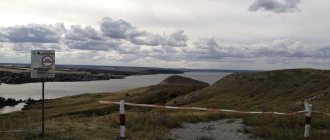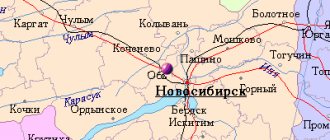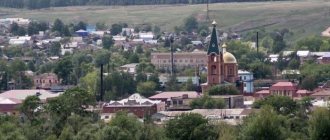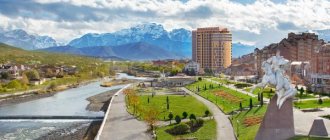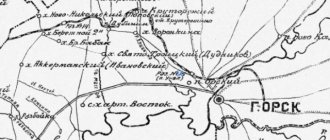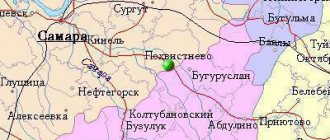The villages are located among lakes on the eastern spurs of the Uraltau ridge - the border between Europe and Asia. Photo by Sergei Sinenko
As it has just become known, the Uchalinsky Mining and Processing Plant (Uchalinsky GOK) has had its subsoil use license revoked. The deposit has reserves of gold, silver, copper and zinc
Sergey Sinenko
In 1842, not far from present-day Uchaly, at the Tsarevo-Alexandrovsky mine of the Tashkutargan deposit in the Orenburg province, the largest nugget in the entire history of gold mining in Russia was found weighing 2 pounds 7 pounds 82 spools, or 36 kilograms 21 grams. It was called the “Big Triangle” and was sent to St. Petersburg with a special convoy. Today the nugget is kept in the State Diamond Fund.
Big triangle
Uchaly is located in a large triangle between the lakes Bolshie Uchaly, Karagaily and an artificial lake. The city consists of three almost equal parts: the modern Uchaly itself, the axis of which is Lenin Street, the industrial zone of the UGOK - Uchaly Mining and Processing Plant with a quarry and dumps, as well as the old part with village-style houses called Uchaly-2. The modern part of the city is located in a valley bounded by three mountains: on one side there are Olotau and Tashly Mountain, on the other there is Mount Lysaya. The main population of the city is Russians, Bashkirs and Tatars.
Uchaly is the object of influence from three spheres: Ufa, to which it is subordinated territorially and administratively, the Ural region, with which it is closely connected economically, as well as Moscow, where many of the current shareholders of the enterprise are located and from where strategic production management is carried out.
Beloretsk-Uchaly road. Photo by Sergei Sinenko
UGOK's main products are copper, zinc and pyrite concentrates. It is supplied to consumers in Russia and foreign countries. More than 70 percent of the country's zinc is mined here! We could put an end to this. But the plant produces another third of all Russian copper. The volumes of gold mining are also significant and remain stable. Silver, platinum and rare metals - indium, tellurium, selenium - are also mined. The underground resources of the Uchalinsky district store more than half of all precious metals of the republic.
UGOK is part of the Ural Mining and Metallurgical Company, a huge holding company that specializes in the extraction and processing of copper pyrite ores. The company is controlled by President Iskander Makhmudov, who occupies 16th place on the Russian Forbes list, as well as General Director Andrei Kozitsyn.
The city of Uchaly and its underground reserves of zinc, copper and gold are today at the center of the interests of powerful industrial and financial groups.
UMMC, thanks to the Chalinsky plant, is the undisputed leader in zinc mining, but not only: for the second year in a row, the holding is the leader in copper production in Russia. In 2011, the company for the first time overtook its competitor Norilsk Nickel, whose main shareholders are Vladimir Potanin and Oleg Deripaska. In 2012, the holding retained its leadership in copper production. All this is due in no small part to the mining and processing plant in Uchaly.
In general, cash flows do not bypass Uchaly. The interests of powerful industrial and financial groups converge here.
The plant is everything for the Uchalovs. The well-being of the city and the region depends on its stable operation, because the enterprise is the main taxpayer of the territory - the share of its contributions is 70 percent of the budget of the Uchalinsky district. Year after year, the plant's independence is growing. This does not mean at all that the UGOK does little for the republic. On the contrary, in any charity or sponsorship program, Usha residents are among the first. But it is important for them that their status is taken into account. Special status.
Do they have the right to do this? Let's try to figure it out.
View of the city blocks from Bald Mountain. Photo by Sergei Sinenko
Symbolism
The flag is a rectangular panel with a width to length ratio of 2:3, consisting of three horizontal stripes: an upper yellow stripe 1/10 the width of the flag, a middle green stripe 4/5 the width of the flag, and a lower yellow stripe; in the center of the green stripe there is a yellow horse galloping towards the pole.
Silver color is a symbol of faith, purity, sincerity, open-heartedness, nobility, especially characteristic of the people of Uchaly.
Green is the color of nature, meaning renewal, freshness, fertility, hope.
Azure is a symbol of eternity, devotion, purity, spirituality and intellectuality.
Approved by the decision of the Council of the municipal district Uchalinsky district of the Republic of Bashkortostan (No. 128) dated July 13, 2006 (amended by the decision of the Council of the MR Uchalinsky district of the Republic of Bashkortostan dated October 24, 2007 No. 317 “On amendments to the decisions of the Council of the municipal district Uchalinsky district of the Republic of Bashkortostan dated July 13, 2006 of the year No. 127 “On the coat of arms of the municipal district Uchalinsky district of the Republic of Bashkortostan”, 128 “On the flag of the municipal district Uchalinsky district of the Republic of Bashkortostan”).
Behind the Ural ridge
The summer moon glides across the sky especially easily. Along the highway to Beloretsk there are small mountain villages and large cemeteries with them. In the north, in the unclear distance, the outlines of the Yamantau peaks can be discerned. Neither movement nor sound is noticeable in the vast space. A morning translucent haze hangs over this entire mountainous country.
We cross the rivers Khakatkasy, Maly Inzer, Kurgaza. On the sloping slopes, without stables or shelter, herds of horses, herds of cows and sheep sleep in the morning silence. In the dampness below the clouds, the animals huddled in dense herds, huddling close to each other.
The morning haze becomes more transparent and thinner. The highway twists and turns, bending around the railway, now to the right, now to the left. Among the trees you can see pits, pits, workings and burial places where gold was once mined. The saucer lakes are turning white. Between the sloping hills the water surface of Lake Bolshie Uchaly opened up. A white lump of snow moved - it turned out to be a flock of swans resting on the lake. A barn spirit came from the water, as if the lake, waking up, yawned...
From hill to hill, from lowland to hillside, from hillside to lowland again, that’s how we got to Uchaly. Travel time is 4 hours 55 minutes. From the Ufa Friendship Monument to the entrance to Uchaly it was exactly 360 kilometers. And by rail it’s even longer, as much as 482 kilometers.
First thoughts: “And how to manage this distant territory from Ufa?!”
In addition, the “Chalino appendix” - as local residents affectionately call their region - is surrounded on all sides by similar industrial centers of the Urals, economic ties with which are much stronger than with central Bashkiria. These ties formed back in the 19th century, and subsequently only intensified, especially since the cities are located very close.
For example, from Uchaly to Verkhneuralsk there are only 60 kilometers by road, to Miass - 107, Magnitogorsk - 112, Chebarkul - 127, Zlatoust - 135, Chelyabinsk - 180. So it has long been the case that the residents of Uchaly and the residents of Chelyabinsk are in the same economic team - both of them are from the Urals.
This year is festive for the Uchalovs. There are posters everywhere: “Happy anniversary, beloved city. 1963 – 2013.” Fifty years is not a long time for a city. Meanwhile, the power of the plant, and subsequently its independence, is only growing. I even heard the following opinion: “As a result of economic transformations and a change of owners of the mining and processing plant, Uchaly became a small state within a state.” Well, this, of course, is overkill... Or maybe there are some reasons to say so?
View of the Uchalinsky mining and processing plant and rock dumps. Photo by Sergei Sinenko
Uchaly on the map of Russia: geography, nature and climate
The city occupied the north of the Bashkir Trans-Urals. He reached out between Fr. Malye Uchaly and Karagaily are right on the spurs of the Ural-Tau ridge (eastern part). A large river runs 12 km east of it . Ural . The municipality is the border between Asia and Europe. It received a unique geographical position - in the intermountain region. It determines the nature, landscape and climate of the city. It's continental here. Winters in Uchaly are cold, and summers are dry and very hot.
Golden Valley
I stayed for a long time in the mountain hall of the local history museum. When his employees got tired of watching me, they were replaced by an elderly, deeply tanned man. We started talking. It started with what he said, pointing to the museum stand with portraits of the directors of the UGOK:
- Look at the photographs. Director Belyaev created our plant. Under Khmelev it collapsed. And Abdrakhmanov restored it again!
Bulat worked at the plant his entire adult life. I got a job as a plumber at a local history museum, today is my first day of work. Bulat commented on each of the museum stands based on the experience of his life.
...The gold rush in the Bashkir Trans-Urals began more than two hundred and fifty years ago, after the discovery of placer gold deposits in the north of the current Uchalinsky region along the valleys of the Buyda, Iremel, Uy, Ural, Shartymka and Krasnokhta rivers. Together with the deposits in the Miass region, the gold belt became one of the main centers of gold mining in Russia.
Mindiyar Latypov lives on the shore of Lake Bolshie Uchaly. Photo by Sergei Sinenko
In the fall of 1824, Emperor Alexander I undertook a trip to the distant provinces of Russia. From Orenburg he went to Ufa, then to the Zlatoust factories, and on September 23 he visited the Tsarevo-Alexandrovsky mine near Miass. Shortly before the arrival of the sovereign, the artisan Dementy Petrov found a nugget. After the head of the Zlatoust mining works, Stepan Tatarnikov, presented the find to the tsar, the emperor expressed a desire to work at the mine himself. That day he dug up 22 pounds of sand, and took the mined gold along with the nugget as a souvenir. After the departure of the sovereign, a stone pyramid with a double-headed gilded eagle was installed at the place where he carried out the work...
A lot about a person is determined by origin. And for the city it is very important where it began. Origins, so to speak. Uchaly grew out of a gold mining village.
One of the first in the area of present-day Uchaly at the end of the 19th century was gold miner Alexey Pribylev. At the Uragan mine, he enriched ore with a high degree of mechanization - on a gold washing machine driven by a steam engine. The gold-bearing Uchalinskoye deposit at that time was known only as an iron ore deposit. The mined brown iron ores contained a lot of sulfur, so they were not smelted, but were processed into the mineral paint ocher.
In the post-revolutionary period, Miass became the center of gold mining. The Miass gold mining district was created, which included the 1st Bashkombinat in Baymak and the 2nd in the village of Polyakovka. Later they merged into the Bashzoloto trust.
When in 1934, the geologist of the Buydinsky mine, Mikhail Dolgal, discovered samples of gold-bearing rock on the shore of Lake Malye Uchaly, Bashzoloto did not pay attention to this, since the precious metal content was no more than two grams per ton of ore. However, five years later, searchers discovered the Uchalinskoye copper-zinc pyrite deposit, which was hidden under a layer of oxidized ores - the so-called “iron hat”. The “hat” was found to have an extremely high gold content, about 500 grams per ton!
Lake Bolshiye Uchaly. Photo by Sergei Sinenko
On Bald Mountain
Loaded to the brim with history, I crawl out of the museum into the light of day to breathe oxygen. Clouds are gathering in the sky, a viscous whitish haze covers the azure of the sky. “No,” I think, “before the rain starts, we need to climb that mountain over there and explore city life from the top.” I walk up Karl Marx Street past the buildings of a reinforced concrete products factory. Further along the path, stumbling over large dark red boulders.
From Bald Mountain there is a view of the central and eastern parts of Uchaly. On the left are factory workshops, garages, behind which is a thirty-meter dam encircling an artificial lake where the water settles after washing the ore. Nearby is the village of Buransy, nicknamed “ghetto,” and the Buida River.
From the southern part, the valley is limited by Tashly Mountain with a television tower at the top and a mosque minaret at the foot. The Yashma hotel, the plant's dispensary, the Ural sanatorium and the Gornyak stadium are located here. The Ferris wheel marks the space of the park of culture and recreation.
There are areas in the city that are called “poor settlement”, and there are also “noble nest”. Everything is the same as everywhere else... Hidden behind the edge of the mountain is the “Tsarskoye Selo” - a village comparable in development to the Ufa Chesnokovka. There are stories told about him. Allegedly, a delegation from the neighboring Tsarskoye Selo district inspected it. Seeing another cottage, they naively admired: “Well done, the houses are not finished yet, but what a huge club they have already built!”
I move to the northern slope of the mountain. From here the mining and processing plant opens in all its glory. In the middle is a quarry, only its edges are visible, already overgrown with small bushes. I remember a photograph of it from a satellite - only from space and you can estimate the scale: depth -380 meters, length - 1800, width - 900. On the slope of the northern side, if you stretch your imagination a little, you can see the silhouette of a woman.
The famous UGOK quarry near Uchaly
Now the deposit is being developed only underground, and the quarry is planned to be reclaimed. But how? It's hard to even imagine. After all, the dumps rise as high as Bald Mountain, and I can’t even believe that these hills are man-made. The dumps are not safe - every year the wind raises at least a ton of dust containing heavy metals into the air. The zone of dangerous contamination covers the mine area and stretches 20 kilometers to the northeast according to the wind rose...
Meanwhile, a cloud was already creeping into the city from the west. From the heights one could see people running to the hangar near the car wash to take shelter from the downpour. A sharp, dazzling zigzag of lightning cut through the space.
Khrushchevsk or Mednouralsk?
On Lenin Street, people pass each other in a hurry, clinging to umbrellas. At the bus stop there are gloomy, worried faces. The bus here runs along the ring road, there are only two routes: in one direction - 1st, in the other - 2nd. People complain: irregularly. Near the Iremel Hotel, taxi drivers lined up - expecting a good profit.
Lenin Street has been licked and polished along its entire length, with many flower arrangements. There are excellent benches around, comfortable and durable. I notice: if you look at the monument to Lenin from the boulevard, the corollas of the kurai, depicted on the facade of the neighboring Philharmonic, diverge from its head in different directions. Someone's idea?
Uchaly, view from Bald Mountain. Photo by Sergei Sinenko
It’s hard to imagine, but fifty years ago there was a swamp here. The entire center of the valley was occupied by a peat swamp, a little higher - the wheat fields of the Yushali collective farm. The wheat yielded a good harvest, but construction workers without rubber boots could only walk in two places - along Stroitelnaya Street and along Stroiteley Lane to the canteen building.
Teacher Roza Muslimova recalls how, after graduating from the pedagogical institute, she came to the village and went to get a job.
– The school was located in a one-story barracks next to the printing house. I put on smart boots, but there was mud all around, it was impossible to get through. I bought rubber boots with the remaining money and only got to school the next day!
On Lenin Square in Uchaly. Photo by Sergei Sinenko
Since the beginning of construction, there has been an ongoing debate about whether the location was chosen correctly? In 1959, the second secretary of the Bashkir regional party committee, Pyotr Uraev, arrived with an unexpected inspection. He called the leaders of the construction trust and the plant and immediately stunned everyone: “What fool decided to put the city in a swamp?” We began to study alternate sites behind the village of Uchaly and towards the Buida River. A commission arrived from Moscow, which studied soil samples, the directions of the prevailing winds, water supply schemes, and in the end confirmed that the place had been chosen correctly. This put an end to a dispute that had lasted for several years.
Soon, the republican regional party committee decided to transform the workers' villages of Malye Uchaly, Novye Uchaly and Mindyak into a city of republican subordination. The general plan was prepared by the famous Leningrad design institute "Lengorproekt", the general customer was the UGOK, and the executor was Trust No. 146.
What to name the future city? Various options were considered. For example, Khrushchevsk. Other proposals are Mednouralsk, Mednouchalinsk, Iremel, Irandyk, Uchalinsk. There was enough common sense to preserve the original name.
Sometimes the word “uchali” is derived from the Bashkir “us aldy” - “revenged” and goes back to the times of Tokhtamysh and Tamerlane - the latter allegedly massacred the nomads of the South Ural Bashkirs who supported Tokhtamysh. A much more convincing version is the origin from “yushala” - this is how the Bashkirs called rocks for making paints. And “yushali” is apparently a variant of “yusha” - jasper, jasper. This is justified - the jasper belt of the Urals passes through here.
Routes on the map of Uchaly. Transport infrastructure
If you look closely at the satellite map of Uchaly, you will see that there is a railway in the city; the nearest station is in the village. Uchaly. Since the settlement was built on mines, the railway tracks run close to the largest industrial facilities.
The transportation of passengers within the city is provided by the only motor transport company, Bashavtrans. Buses run on two main routes. But the city has a well-developed taxi industry. There are over 13 taxi services in Uchaly.
Dobraya and Lugovaya streets
In the city center, the streets are named the same as everywhere else - Lenin, 50 Let Oktyabrya, Karl Marx, Komsomolskaya and Sovetskaya. But there are names with pronounced local specifics - Gornyakov, Gornozavodskaya, Geologov, Remeslennaya, Yashmovaya. In the new microdistricts, the names have no ideological content at all, but they make you smile - Dobraya, Svetlaya, Brusnichnaya, Zemlyanichnaya, Lazurnaya, Lugovaya, Medovaya, Rodnikovaya streets.
There are some completely unexpected ones.
– Why Marina Tsvetaeva Street? Was the poetess really passing through these places?
– No, we just usually ask our residents who has any ideas. Someone suggested Tsvetaeva. We read the poems and liked them.
I notice something strange. The odd-numbered houses of Gorky Street are not located opposite the even-numbered houses, but across the blocks of Lenin and Bashkortostan streets. Passers-by explain that this happened because Gorky Street used to be a city outskirts.
– When the city expanded, the street was “moved”, new neighborhoods arose, and only then they began to build up the even side of Gorky Street. There is no need to change the numbering, and everyone knows that...
Mysterious stranger from Uchaly. Photo by Sergei Sinenko
In the city center, all the lower floors are occupied by shops. I turn into Stroiteley Lane. There is a small park in front of the music school. In the center is a tall obelisk with a star and the figure of a victorious warrior. There are two steles on the sides. On one there is the inscription “Eternal memory of the victims of political repression”, on the other - “April 26 – Day of Remembrance for those killed in radiation accidents and disasters.” Girls are eating ice cream on a bench. Olya and Gulnar are studying at a mining technical school with a degree in land and property relations.
– What events are happening?
– The loudest thing was the “Chelyabinsk meteorite” flying right over the city. No one saw the meteorite itself, but many noticed the flash of light and the trail.
At the intersection I see a film crew. I come over and let’s get acquainted. Uchaly-TV news department correspondent Natalya Prokopyeva is reporting from the city streets on the topic “poisoning with unwashed fruits.” The city of Uchaly has its own channel, independent of republican broadcasting. There are twenty people on staff and there are news, advertising and congratulations departments. A five-minute news release is published daily, and at the end of the week there is a final program. Among children's programs, “Fidgets” and “Living Corner” are popular.
– What about the environment?
- Well, we don’t talk about this at all...
In the south-eastern part of the city, behind the market and bus station, there is a city beach. Passing by and looking at the long-haired girls swimming in the lake, I think: it would be nice to write “A Field Guide to Bashkir Mermaids.”
I got into a conversation with one of the “mermaids”.
– How does Uchaly differ from other cities in the Trans-Ural region? - I ask Alfia, the flower seller.
– There was no nationalism in Uchaly, there is no and there never will be! – she states categorically.
– Although professors came from Ufa, angry as dogs, they gave lectures - it’s a shame to listen... The fact is that the cream of the intelligentsia, people of an intellectual bent, came to the plant from all over Russia. Next to them, others rose up and became more cultured. And the plant gathered the best Bashkirs from the Uchalinsky district. They all worked together and eventually got married. This is why our girls are very beautiful. And also smart. This is because the cult of knowledge at school was and remains!
Seeing me nod in agreement, Alfiya developed the topic:
– We are brought up in a special atmosphere, so in Uchaly the relations between people are very soft. Uchali residents have a broader view of life. Even Bashkir literature has its own here. Could Anatoly Genatulin make it in Ufa? Never! And Moscow accepted him as one of their own, because they understood that he was a talented person. His real name is Talkha Giniyatullin. A great, completely misunderstood man. Who else spoke with such nakedness about rural Bashkirs? Who would have the courage?!
Uchaly, on the square. Photo by Sergei Sinenko
I walk through the courtyards, recording what is hidden in the everyday. A gaggle of girls with strollers are heatedly discussing something - they’re the ones I need! We walk along the playground. One baby rides in a stroller standing up, like the Minister of Defense at a parade on Red Square.
It’s easy to talk about everything with Larisa, Ekaterina, and Elena. Ufa universities are not listed in Uchaly; they usually go to Moscow, St. Petersburg, Samara, Chelyabinsk and Yekaterinburg to study. They enter Moscow State University, Baumanova. Competent mathematicians, physicists, and geologists are especially held in high esteem. This is understandable: the plant and other enterprises in the city do not need accountants, economists and managers. But there are not enough workers, we need qualified underground workers.
Complain:
– Too many banks have collapsed. There are vacuum cleaner banks, they work at one percent a day, and the task is to take every last thing from a person. The state does not protect people. But the people themselves understand this poorly. What does one percent mean to our people?! They peck. And the bank is doing everything to turn it into a thousand and one!
Then a strong wind rose and it began to rain. Before leaving, I take a photo of the company, and Elena laughs:
– I know what your photograph will be called: “Uchalinsky mothers walk in any weather!”
“Uchalinsky mothers walk in any weather!” Photo by Sergei Sinenko
The general impression of Uchaly is that the city is clean and well-groomed. Not only the central streets, but also the side streets. It is not for nothing that Uchaly has already been recognized several times as the best small town at various levels - both in the Volga region and even across Russia.
People are open and friendly. There are many beautiful, slender girls on the streets. Although there are virtually no universities in Uchaly, except for a small branch of Bashkir State University, you often meet people of an intellectual bent - reserved, well-mannered, well-dressed. In this way, Uchaly is reminiscent of defense cities, for example, Tomsk-16.
Mosque named after Zainulla Rasulev. Photo by Sergei Sinenko
Main city streets of Uchalov
Looking at the map of Uchaly with streets, it seems as if the city is completely cut up by streets and alleys. Moreover, the houses and buildings on them have an amazing location. On the master plan of the municipality, the main streets are marked as follows:
- Gorky. Its houses with odd numbers are not located opposite buildings with even numbers, but across the street objects. Bashkortostan and Lenin.
- Mira.
- Power engineers.
- Imangulovskaya.
- Ismagila Sultanov.
- Shaimuratova.
Crescent and cross
Until recently, in Uchaly, as in any Soviet industrial city, there was almost no religious life. Today there are two mosques in the city, one Orthodox church and another one is being built nearby. From the side of Mira Street I go up the hill. In front of me is a mosque built in honor of the Bashkir Sufi Zainulla Rasulev, and in the next block one can see the domes and crosses of the Orthodox Church of St. Panteleimon.
Dim-hazrat, imam-khatib of the mosque named after Zainulla Rasulev. Photo by Sergei Sinenko
Salavat Nasyrov, honorary imam-khatib of the Uchalinsky district. Photo by Sergei Sinenko
Uchaly is a young city, and architectural antiquity simply cannot be found here. But further north along the highway to Miass is the ancient gold mining village of Voznesenka, which is famous for its amazing church - an outstanding work of architecture, which has no equal in the entire Trans-Urals. It would be a shame not to visit!
The highway leads north into the old gold-bearing area. The road either approaches or moves away from the Uy River, the bed of which is dammed by dumps of rock left after gold mining by dredging. We are entering Polyakovka, an old, large village, where gold mining has been carried out since the 18th century. Stone shopping arcades, storehouses and two-story buildings of excellent brickwork have been preserved here. In the 1930s, the center of gold mining was located in Polyakovka - the 2nd Bashkir plant “Tsvetmetzoloto”.
Further on there is a dirt road along the Nuralinsky ridge. From the hill there is a view of the valley, where Voznesenka lies near the Alabiya ridge and Mount Uytash. There is no gas here, they heat it with birch. There is no Internet, no cell phone service. Not earth, but heaven!
The first wooden church in Voznesenka was built in 1876, when, due to the influx of miners, the village grew into a large village. Thirty years later a stone church was erected. It was built by ore miners, whose houses were almost all two-story, rich, so the temple was large, five-domed, in the Byzantine style. The walls were painted by masters specially hired from Italy. A monument was erected next to the church in honor of the liberation of peasants from serfdom. Previously broken, mangled, desecrated, it has now been restored by the church parish.
Priest Father Andrei says that there are no funds to restore the unique temple.
– We just maintain it in its current state. In winter, the temperature inside does not drop below 15 - 20 degrees Celsius.
Excursions are organized from neighboring villages. to see the temple in Voznesenka. Photo by Sergei Sinenko
Father Andrey, rector of the temple. Photo by Sergei Sinenko
Uchalov resident Alexey and his family are relaxing on nearby Lake Vorozheich. He is an engineer and is concerned about the problems of mining automation. And not only them.
– You know, the most damage was done to the temple during Gorbachev’s perestroika. They plundered, broke the masonry - they looked for treasures and underground passages. It seems that you live on land that was left by a highly organized human tribe, and was occupied by feral aliens from nowhere. These are creatures with animal instincts who deny everything. Don’t lie, don’t kill, don’t covet someone else’s, don’t make an idol for yourself - all the commandments have been replaced with the opposite ones! The main thing for them is money, enrichment, gold...
Unanswered Questions
This spring, an event occurred that was directly related to the topic. The arbitration court deprived the authorities of Bashkortostan of a place on the board of directors of UGOK. The fact is that when the plant was corporatized in 1992, the republic received a “golden share”, which gave it the right to veto at the general meeting when voting on key issues. The presence of a “golden share” made it possible to include representatives of the republic on the board of directors and audit commission without elections. Since the validity period of the “golden share” had expired, the court declared the special right of Bashkiria to manage the plant terminated.
This does not mean that the republic was left without levers of enterprise management. But with the growth of independence and strength, the responsibility of the plant for the fate of its workers and all the residents of Uchaly who are related to it by blood also grows. Including for their lives. Moreover, miners' work is dangerous, and tragedy cannot always be avoided. I am referring not only to the cases that are widely discussed, but also to the recent case at the mine in Mezhozernoye, where a worker was drowned in the mine.
In recent times, Polyakovka was the center of gold mining. Photo by Sergei Sinenko
Environmental ecology and health protection remain a big problem; there are studies, for example by Z. F. and R. A. Askarov and others, that describe the situation without much optimism.
But many of the problems that plague the plant concern the entire country. The barracks-like organization of life and defense consciousness are a thing of the past, and along with them, enthusiasm and work ethic. There was a breakdown of the entire value system, the entire military-communist ideology. Withdrawal, not cleansing. No new ideology arose. We have been waiting for the promised “national idea”, but in its place there is a gaping void, a pit.
We, as a people, entered the new century not so much lightly, but completely empty. Thousands of people, freed from the fear of being caught in ignorance, rushed to organize their private lives. A surge in everyday life, impulsive, greedy, somewhat flawed, absorbs all mental strength. But somehow it turns out that life doesn’t get any better. Satiety? When was life measured by satiety alone?!
I didn’t see much in Uchaly, but I was able to understand that there is a collective memory of the builders of the city and the plant. I felt that there were collective questions that could be formulated as follows.

